Reviving from the Pandemic: Harnessing the Power of Social Media Reviews in the Sustainable Tourism Management of Group Package Tours
Abstract
1. Introduction and Background
Objectives and Significance of This Study
- How are positive, negative, and inconsistent or “mixed” (both positive and negative present simultaneously) eWOM associated with consumers’ perceptions of value for a GPT?
- What influence does eWOM have on the effects of the acceptability level of price on value perceptions for a GPT?
2. Literature Review and Hypothesis Development
2.1. Electronic Word-of-Mouth (eWOM)
2.2. Perceived Value
2.3. Acceptability Level of Price and Final Perceived Price
2.4. The Moderating Effects of eWOM on the Influence of Price Acceptability Levels and Its Negativity Effect on Consumers’ Final Price Perceptions
2.5. Perceived Quality
2.6. The Moderating Effects of eWOM on the Influence of Price Acceptability Levels on Consumers’ Quality Perceptions
2.7. The Moderating Effects of eWOM on the Influence of Price Acceptability Levels and Its Negativity Effect on Consumers’ Value Perceptions
3. Methodology
3.1. Experimental Research Design
3.2. Data Collection and Sampling Method
3.3. Adequacy of Measurement
3.4. Analytic Procedures
4. Findings
4.1. Effect of eWOM Versus Price Acceptability Level on Price and Quality Perceptions
4.2. The Moderating Effects of eWOM on the Relationship Between Price Acceptability Level and Value Perception
4.3. Negativity Effect of eWOM Valences on Value Perception
5. Discussion and Conclusions
5.1. Implications for Industry Practitioners
5.2. Theoretical Contributions
6. Limitations and Future Research
Author Contributions
Funding
Institutional Review Board Statement
Informed Consent Statement
Data Availability Statement
Conflicts of Interest
Appendix A. Sample Survey Questionnaire
- Section I
- Full 5 day trip: arrive at Tokyo in Day 1 early morning & depart in the evening of Day 5
- Covering Tokyo, Nikko, Mt. Fuji, Hakone, Kyoto & Nara
- Theme park: Tokyo DisneySea Park
- Sightseeing: Toshogu Grand Shrine (World Heritage), Mt.Fuji, Nijo Castle, Kinkakuji Temple (Golden Pavillion), Gion Area, Horyuji Temple, Deer Park
- Shopping: Ginza, Shinjuku
- High quality accommodation: 4-star hotels (Grand Hotel Takanawa, Miyako Hotel)
- High quality meals: renowned sushi/green tea in Ponto-cho restaurants/tea-houses and other famous local cuisines in restaurants en-route
- Airline: Cathay Pacific
- Section II
- Section III

- Minimum price: HK$ ____________ (USD: ____________)
- Maximum price: HK$ ____________ (USD: ____________)

- Section IV
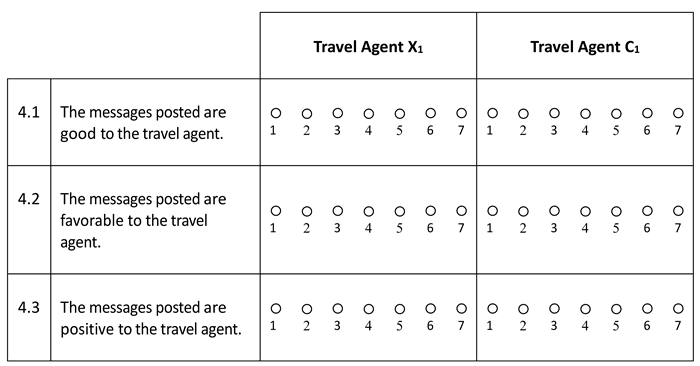
- Section V
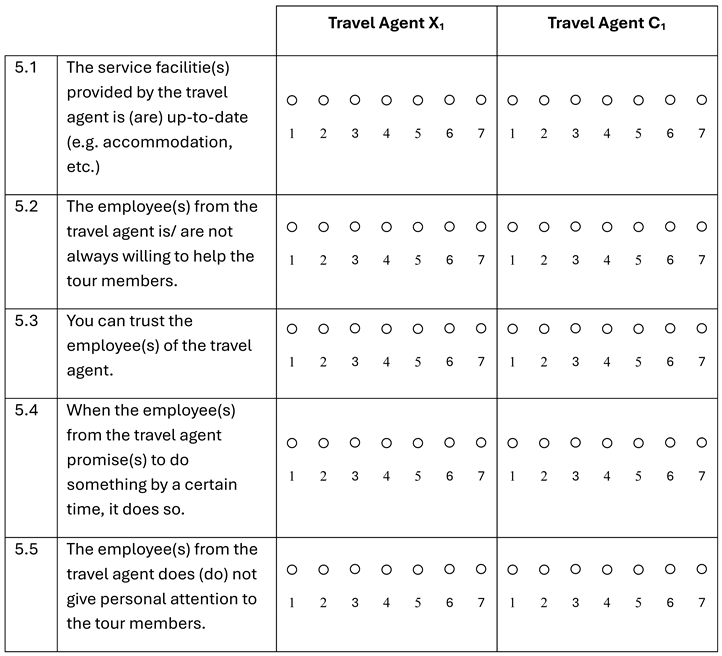
- Section VI
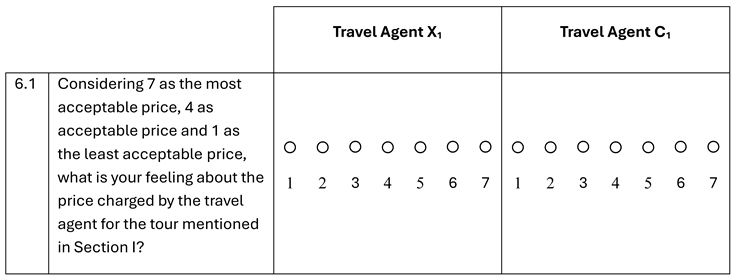
- Section VII
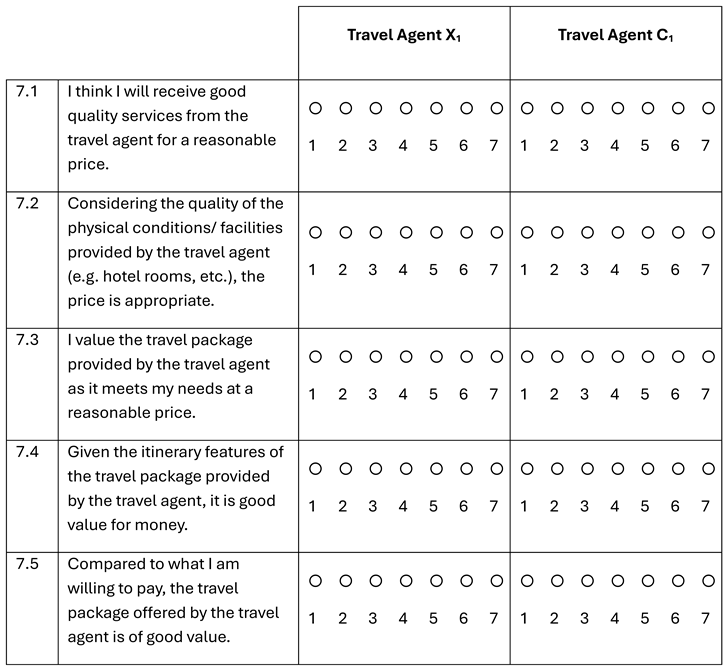
References
- Adinolfi, M. C., Harilal, V., & Giddy, J. K. (2021). Travel stokvels, leisure on lay-by, and pay at your pace options: The post COVID-19 domestic tourism landscape in South Africa. African Journal of Hospitality, Tourism and Leisure, 10(1), 302–317. [Google Scholar] [CrossRef]
- Al-Sabbahy, H. Z., Ekinci, Y., & Riley, M. (2004). An investigation of perceived value dimensions: IMPLICATIONS for hospitality research. Journal of Travel Research, 42, 226–234. [Google Scholar] [CrossRef]
- Anderson, E. W. (1998). Customer satisfaction and word of mouth. Journal of Service Research, 1(1), 5–17. [Google Scholar] [CrossRef]
- Aprilia, F., & Kusumawati, A. (2021). Influence of electronic word of mouth on visitor’s interest in tourism destinations. Journal of Asian Finance, Economics and Business, 8(2), 993–1003. [Google Scholar] [CrossRef]
- Arndt, J. (1967). Word-of-mouth advertising and informal communication. In D. Cox (Ed.), Risk taking and information handling in consumer behavior. Havard University. [Google Scholar]
- Aurylaitè, P., & Correia, R. (2022). The electric car charging market in Latvia: BUSINESS recommendations for new players in the market. European Journal of Applied Business Management, 2022, 1–16. [Google Scholar]
- Bagozzi, R. P., & Yi, Y. (1988). On the evaluation of structural equation models. Journal of the Academy of Marketing Science, 16(1), 74–94. [Google Scholar] [CrossRef]
- Banerjee, S., & Chua, A. Y. K. (2019). Trust in online hotel reviews across review polarity and hotel category. Computers in Human Behavior, 90, 265–276. [Google Scholar] [CrossRef]
- Basri, N. A.-H., Ahmad, R., Anuar, F. I., & Ismail, K. A. (2016). Effect of word of mouth communication on consumer purchase decision: Malay upscale restaurant. Procedia—Social and Behavioral Sciences, 222, 324–331. [Google Scholar] [CrossRef]
- Benavides Franco, J., Alonso Cifuentes, J. C., Carabalí Mosquera, J. A., & Sosa, A. (2022). On the feasibility of reverse mortgages in Colombia. International Journal of Housing Markets and Analysis, 15(5), 1195–1224. [Google Scholar] [CrossRef]
- Blal, I., & Sturman, M. C. (2014). The differential effects of the quality and quantity of online reviews on hotel room sales. Cornell Hospitality Quarterly, 55(4), 365–375. [Google Scholar] [CrossRef]
- Boksberger, P. E., & Melsen, L. (2011). Perceived value: A critical examination of definitions, concepts and measures for the service industry. Journal of Services Marketing, 25(3), 229–240. [Google Scholar] [CrossRef]
- Bone, P. F. (1992). Determinants of word-of-mouth communications during product consumption. Advances in Consumer Research, 19, 579–583. [Google Scholar]
- Bruner, G. C., II, & Hensel, P. J. (1992). Marketing scales handbook: A compilation of multi-item measures. American Marketing Association. [Google Scholar]
- Buttle, F. A. (1998). Word-of-mouth: Understanding and managing referral marketing. In Proceedings of the Academy of Marketing Annual Conference (pp. 100–106). Sheffield Hallam University. [Google Scholar]
- Catur Widayati, C., Yenita, Arijanto, A., Ayu Diporini, V., Edwina Oebit, C., & Suryaningrum, D. (2023). Antecedents and consequences of personal selling, price and product quality on buying incentive packages tour travel post-COVID-19 pandemic. KnE Social Sciences, 8(12), 596–608. [Google Scholar] [CrossRef]
- Chang, J.-H., & Wang, S.-H. (2019). Different levels of destination expectation: The effects of online advertising and electronic word-of-mouth. Telematics and Informatics, 36, 27–38. [Google Scholar] [CrossRef]
- Chen, I.-F., Kuo, P.-Y., & Tsaur, R.-C. (2022). Price risk strategy analysis for budget hotels in the post-pandemic era. Axioms, 11, 550. [Google Scholar] [CrossRef]
- Chena, H.-S., Chen, C.-Y., Chen, H.-K., & Hsieh, T. (2012). A study of relationships among green consumption attitude, perceived risk, perceived value toward hydrogen-electric motorcycle purchase intention. AASRI Procedia, 2(2012), 163–168. [Google Scholar] [CrossRef]
- Choi, C. (2022). Comparing word-of-mouth (WOM) and viral marketing: Behavior analysis of consumer consumption, information traits, and credibility. Hong Kong Journal of Social Sciences, 60, 326–333. [Google Scholar]
- Chou, W. P., Wang, P. W., Chen, S. L., Chang, Y. P., Wu, C. F., Lu, W. H., & Yen, C. F. (2020). Voluntary reduction of social interaction during the COVID-19 pandemic in Taiwan: Related factors and association with perceived social support. International Journal of Environmental Research and Public Health, 17(21), 8039. [Google Scholar] [CrossRef] [PubMed] [PubMed Central]
- Cohen, J. (1988). Statistical power analysis for the behavioral sciences (2nd ed.). L. Erlbaum Associates. [Google Scholar]
- Cronin, J. J., & Taylor, S. A. (1994). Servperf versus servqual: Reconciling performance-based and perceptions-minus-expectations measurements. Journal of Marketing, 58(1), 125–131. [Google Scholar] [CrossRef]
- Czerny, A. I., Fu, X.-W., Lei, Z., & Oum, T. H. (2021). Post pandemic aviation market recovery: Experience and lessons from China. Journal of Air Transport Management, 90(2021), 1019–1071. [Google Scholar] [CrossRef]
- de Ruyter, K., Wetzels, M., & Jos, M. (1997). The dynamics of the service delivery process: A value-based approach. international Journal of Research in Marketing, 14(3), 231–243. [Google Scholar] [CrossRef]
- Ding, L., & Romainoor, N. H. (2022). Examining factors affecting consumers’ purchase intentions for chinese museum’s cultural and creative products. Asian Journal of Arts, Culture and Tourism, 4(2), 1–11. [Google Scholar]
- Dolnicar, S., & Ring, A. (2014). Tourism marketing research: Past, present and future. Annals of Tourism Research, 47(7), 31–47. [Google Scholar] [CrossRef]
- Drolet, A., & Morrison, D. (2001). Do we really need multiple-item measures in service research? Journal of Service Research, 3(3), 196–204. [Google Scholar] [CrossRef]
- East, R., Uncles, M. D., Romaniuk, J., & Lomax, W. (2016). Measuring the impact of positive and negative word of mouth: A reappraisal. Australasian Marketing Journal, 24(1), 54–58. [Google Scholar] [CrossRef]
- Eggert, A., Ulaga, W., Frow, P., & Payne, A. (2018). Conceptualizing and communicating value in business markets: From value in exchange to value in use. Industrial Marketing Management, 69, 80–90. [Google Scholar] [CrossRef]
- Erdmann, A., Mas, J. M., & de Obesso, M. (2023). Disruptive technologies: How to influence price sensitivity triggering consumers’ behavioural beliefs. Journal of Business Research, 158, 1136–1145. [Google Scholar] [CrossRef]
- Filieri, R., Lin, Z., Pino, G., Alguezaui, S., & Inversini, A. (2021). The role of visual cues in eWOM on consumers’ behavioral intention and decision. Journal of Business Research, 135(2021), 663–675. [Google Scholar] [CrossRef]
- Fitzsimons, G. J., & Lehmann, D. R. (2004). Reactance to recommendations: When unsolicited advice yields contrary responses. Marketing Science, 23, 1–172. [Google Scholar] [CrossRef]
- Fornell, C., & Larcker, D. F. (1981). Evaluating structural equation models with unobservable variables and measurement errors. Journal of Marketing Research, 18(1), 39–50. [Google Scholar] [CrossRef]
- Gabbott, M. (2004). Introduction to marketing: A value exchange approach (pp. 35–59). Pearson Prentice Hall. [Google Scholar]
- Garvin, D. A. (1983). Quality on the line. Harvard Business Review, 61, 65–73. [Google Scholar]
- Garvin, D. A. (1987). Competing on the eight dimensions of quality. Harvard Business Review, 65, 101–109. [Google Scholar]
- Han, S., Gupta, S., & Lehmann, D. R. (2001). Consumer price sensitivity and price thresholds. Journal of Retailing, 77(4), 435–456. [Google Scholar] [CrossRef]
- Hennig-Thurau, T., Wiertz, C., & Feldhaus, F. (2015). Does twitter matter? The impact of microblogging word of mouth on consumers’ adoption of new movies. Journal of the Academy of Marketing Science, 43, 375–394. [Google Scholar] [CrossRef]
- Henseler, J., Ringle, C. M., & Sinkovics, R. R. (2009). The use of partial least squares path modeling in international marketing. In New challenges to international marketing (pp. 277–319). Emerald Group Publishing Limited. [Google Scholar]
- Ho, C.-L., Liu, Y., & Chen, M.-C. (2022). Antecedents and consequences of consumers’ attitudes toward live streaming shopping: An application of the stimulus–organism–response paradigm. Cogent Business & Management, 9(1), 2145673. [Google Scholar] [CrossRef]
- Jacoby, J., & Olson, J. C. (1977). Consumer response to price: An attitudinal, information processing perspective. In Y. Wind, & P. Greenberg (Eds.), Moving ahead with altitude research (pp. 73–86). American Marketing Association. [Google Scholar]
- Jacoby, J., & Olson, J. C. (1985). Perceived quality: How consumers view stores and merchandise. Lexington Books. [Google Scholar]
- Jakuba, K., Katarínab, R., & Máriaa, K. B. (2022). Price sensitivity testing as a basic tool for strategic pricing decisions. Strategic Management, 28(1), 20–32. Available online: https://scindeks.ceon.rs/article.aspx?artid=1821-34488800030K (accessed on 1 March 2025).
- Kahneman, D., & Tversky, A. (1979). Prospect theory: An analysis of decisionunder risk. Econometrica, 47(2), 263–291. [Google Scholar] [CrossRef]
- Kalwani, M. U., & Yim, C.-K. (1992). Consumer price and promotion expectations: An experimental study. Journal of Marketing Research, 29, 90–100. [Google Scholar] [CrossRef]
- Kalyanaram, G., & Winer, R. S. (1995). Empirical generalizations from reference price research. Marketing Science, 14(3), 161–169. [Google Scholar] [CrossRef]
- King, R. A., Racherla, P., & Bush, V. D. (2014). What we know and don’t know about online word-of-mouth: A review and synthesis of the literature. Journal of Interactive Marketing, 28(3), 167–183. [Google Scholar] [CrossRef]
- Kunkel, T., Doyle, J. P., & Berlin, A. (2017). Consumers’ perceived value of sport team games: A multidimensional approach. Journal of Sport Management, 31(1), 80–95. [Google Scholar] [CrossRef]
- Kuo, H. C., & Nakhata, C. (2019). The impact of electronic word-of-mouth on customer satisfaction. Journal of Marketing Theory and Practice, 27(3), 331–348. [Google Scholar] [CrossRef]
- Kushcheva, N., & Eilola, T.-M. (2023). Relevance of social media management in online reputation building in tourism and hospitality: Case of Finland. In R. Rialti, Z. Kvítková, & T. Makovník (Eds.), Online reputation management in destination and hospitality (pp. 163–174). Emerald Publishing Limited. [Google Scholar]
- Lacroix, C., & Jolibert, A. (2017). Mediational role of perceived personal legacy value between consumer agentic generativity and attitudes/buying intentions toward luxury brands. Journal of Business Research, 77(C), 203–211. [Google Scholar] [CrossRef]
- Lai, A. W. (1995). Consumer values, product benefits and customer value: A consumption behavior approach. Advances in Consumer Research, 22(1), 381–388. [Google Scholar]
- Lee, A. V., Vargo, J., & Seville, E. (2013). Developing a tool to measure and compare organizations’ resilience. Natural Hazards Review, 14(1), 29–41. [Google Scholar] [CrossRef]
- Liang, W. K., & Corkindale, D. R. (2016). The effect of online word of mouth on risk assessment for an experience service as price acceptability changes. Services Marketing Quarterly, 37(3), 156–170. [Google Scholar] [CrossRef]
- Liang, W. K., & Corkindale, D. R. (2017). Word of mouth or price matters in quality considerations? Asian Journal of Marketing, 11(1), 34–43. [Google Scholar] [CrossRef]
- Liang, W. K., & Corkindale, D. R. (2019). How eWord of mouth valences affect price perceptions. International Journal of Market Research, 61(1), 50–63. [Google Scholar] [CrossRef]
- Lin, C., Sher, P. J., & Shih, H. (2005). Past progress and future directions in conceptualizing customer perceived value. International Journal of Service Industry Management, 16(4), 318–336. [Google Scholar] [CrossRef]
- Liu, H., Osburg, V. S., Yoganathan, V., & Cartwright, S. (2021). Social sharing of consumption emotion in electronic word of mouth (eWOM): A cross-media perspective. Journal of Business Research, 132, 208–220. [Google Scholar] [CrossRef]
- Loncaric, D., Ribaric, I., & Farkas, V. (2016). The role of electronic word-of-mouth in tourism market. In Tourism & hospitality industry (pp. 188–203). Faculty of Tourism and Hospitality Management. Available online: https://www.researchgate.net/publication/305332025_THE_ROLE_OF_ELECTRONIC_WORD-OF-MOUTH_IN_THE_TOURISM_MARKET (accessed on 2 January 2022).
- Long, E., Patterson, S., Maxwell, K., Blake, C., Pérez, R. B., Lewis, R., Lewis, R., McCann, M., Riddell, J., Skivington, K., Wilson-Lowe, R., & Mitchell, K. R. (2022). COVID-19 pandemic and its impact on social relationships and health. Journal of Epidemiology and Community Health, 76, 128–132. [Google Scholar] [CrossRef] [PubMed]
- Lo Presti, L., Maggiore, G., & Marino, V. (2022). Chapter 19: Digital communication tools and tourism engagement: Instant CRM strategies through instant messaging apps. In Handbook on tourism and social media. Edward Elgar Publishing. [Google Scholar] [CrossRef]
- Lou, C., & Yuan, S. (2019). Influencer marketing: How message value and credibility affect consumer trust of branded content on social media. Journal of Interactive Advertising, 19(1), 58–73. [Google Scholar] [CrossRef]
- Mani, A., Balaji, A. L., Hari, A. S., & Sunny, B. (2023). How does customer rating affect product purchase? EPRA International Journal of Multidisciplinary Research (IJMR), 9(1), 94–96. [Google Scholar] [CrossRef]
- Marshall, R., & Bee Leng, S. (2002). Price threshold and discount saturation point in Singapore. Journal of Product & Brand Management, 11(3), 147–159. [Google Scholar] [CrossRef]
- Mathwick, C., Malhotra, N., & Rigdon, E. (2001). Experiential value: Conceptualization, measurement and application in the catalog and internet shopping environment. Journal of Retailing, 77(1), 39–56. [Google Scholar] [CrossRef]
- Mathwick, C., Malhotra, N., & Rigdon, E. (2002). The effect of dynamic retail experiences on experiential perceptions of value: An internet and catalog comparison. Journal of Retailing, 78(1), 51–60. [Google Scholar] [CrossRef]
- Mattila, A. S., & Patterson, P. G. (2004). Service recovery and fairness perceptions in collectivist and individualist contexts. Journal of Service Research, 6(4), 336–346. [Google Scholar] [CrossRef]
- Mazumdar, T., & Jun, S. Y. (1992). Effects of price uncertainty on consumer purchase budget and price thresholds. Marketing Letters, 3, 323–330. [Google Scholar] [CrossRef]
- Miller, J. L., Craighead, C. W., & Karwan, K. R. (2000). Service recovery: A framework and empirical investigation. Journal of Operations Management, 18(4), 387–400. [Google Scholar] [CrossRef]
- Monroe, K. B. (1990). Pricing: Making profitable decisions (2nd ed.). McGraw-Hill. [Google Scholar]
- Monroe, K. B., & Petroshius, S. M. (1981). Buyers’ perception of price: An update of the evidence. In H. H. Kassarjian, & T. S. Robertson (Eds.), Perspectives in consumer behavior (3rd ed., pp. 43–55). Scott, Foresman and Company. [Google Scholar]
- Mortimer, K., & Pressey, A. (2013). Consumer information search and credence services: Implications for service providers. Journal of Services Marketing, 27, 49–58. [Google Scholar] [CrossRef]
- Nachtigall, C., Kroehne, U., Funke, F., & Steyer, R. (2003). (Why) should we use SEM? Pros and cons of structural equation modeling. Methods of Psychological Research, 8(2), 1–22. [Google Scholar]
- Naujoks, A., & Benkenstein, M. (2020). Who is behind the message? The power of expert reviews on eWOM platforms. Electronic Commerce Research and Applications, 44, 101015. [Google Scholar] [CrossRef]
- Ngarmwongnoi, C., Oliveira, J. S., AbedRabbo, M., & Mousavi, S. (2020). The Implications of eWOM adoption on the customer journey. Journal of Consumer Marketing, 37(7), 749–759. [Google Scholar] [CrossRef]
- Nilakant, V., Walker, B., van Heugen, K., Baird, R., & De Vries, H. (2014). Research note: Conceptualising adaptive resilience using grounded theory. New Zealand Journal of Employment Relations, 39(1), 79–86. [Google Scholar]
- Nunnally, J. C. (1994). Psychometric theory (3rd ed.). Tata McGraw-Hill Education. [Google Scholar]
- Pai, C.-H., Ko, K.-M., & Santos, T. (2019). A study of the effect of service recovery on customer loyalty based on marketing word of mouth in tourism industry. Revista de Cercetare si Interventie Sociala, 64, 74–84. [Google Scholar] [CrossRef]
- Pascual, J. J. (2022). Non-monetary price perceived in e-peer-to-peer accommodation: Airbnb guests’ perspective. Tec Empresarial, 17(2), 82–94. [Google Scholar]
- Pawar, P. (2022). Era of influencer marketing: A review report. International Journal of Food and Nutritional Sciences, 11(1), 3258–3265. [Google Scholar]
- Phillips, P., Zigan, K., Santos, S. M. M., & Schegg, R. (2015). The interactive effects of online reviews on the determinants of Swiss hotel performance: A neural network analysis. Tourism Management, 50, 130–141. [Google Scholar] [CrossRef]
- Price, P. C., Jhangiani, R., Chiang, I.-C. A., Leighton, D. C., & Cuttler, C. (2017). Research Methods in Psychology (3rd American ed.). PB Press. [Google Scholar]
- Raykov, T., & Penev, S. (2002). Exploring structural equation model misspecifications via latent individual residuals. In G. A. Marcoulides, & I. Moustaki (Eds.), Latent variable and latent structure models (pp. 121–134). Lawrence Erlbaum. [Google Scholar]
- Rosario, A. B., Sotgiu, F., De Valck, C., & Bijmolt, T. H. A. (2016). The effect of electronic word of mouth on sales: A meta-analytic review of platform, product, and metric factors. Journal of Marketing Research, 53(3), 297–318. [Google Scholar] [CrossRef]
- Rossiter, J. R. (2002). The C-OAR-SE procedure for scale development in marketing. International Journal of Research in Marketing, 19(4), 305–335. [Google Scholar] [CrossRef]
- Roy, A., & Ortiz, M. (2023). Is it risky to subscribe? Perceived control and subscription choice. Psychology & Marketing, 40, 365–372. [Google Scholar]
- Roy, G., Datta, B., Mukherjee, S., & Basu, R. (2020). Effect of eWOM stimuli and eWOM response on perceived service quality and online recommendation. Tourism Recreation Research, 46(4), 457–472. [Google Scholar] [CrossRef]
- Sandberg, J., & Alvesson, M. (2021). Meanings of theory: Clarifying theory through typification. Journal of Management Studies, 58(2), 487–516. [Google Scholar] [CrossRef]
- Sar, A. K. (2022). Price estimation for amazon prime video in India. J Revenue Pricing Management, 22, 312–318. [Google Scholar] [CrossRef]
- Schijns, J., & Bruggen, N. V. (2018). The power of eWOM through social networking sites. Abstract from International Conference on Marketing, Tourism & Hospitality, Zurich, Switzerland. Available online: http://globalbizresearch.org/Swiss_Conference_2018_July3/docs/doc/4.%20Education/ZT862.pdf (accessed on 1 March 2025).
- Sethuraman, R., & Tellis, G. (2002). Does manufacturer advertising suppress or stimulate retail price promotions? Analytical model and empirical analysis. Journal of Retailing, 78, 253–263. [Google Scholar] [CrossRef]
- ShabbirHusain, R. V., & Varshney, S. (2022). Investigating combined effect of WOM and eWOM: Role of message valence. Journal of Consumer Marketing, 39(2), 180–190. [Google Scholar]
- Shen, Y., Li, S., & DeMoss, M. (2012). The effect of quantitative electronic word of mouth on consumer perceived product quality. International Journal of Management and Marketing Research, 5(2), 19–29. [Google Scholar]
- Singh, S. K., & Kathuria, L. M. (2019). Factors influencing e-word-of-mouth adoption among consumers availing travel services. International Journal of Tourism Policy, 9(2), 155–173. Available online: https://www.inderscienceonline.com/doi/abs/10.1504/IJTP.2019.102652 (accessed on 14 January 2022). [CrossRef]
- Slater, S. F., & Narver, J. C. (2000). Intelligence generation and superior customer value. Journal of the Academy of Marketing Science, 28(1), 120–128. [Google Scholar] [CrossRef]
- Sánchez-Fernández, R., & Iniesta-Bonillo, Á. M. (2007). The concept of perceived value: A systematic review of the research. Marketing Theory, 7, 427–451. [Google Scholar] [CrossRef]
- Srivastava, A., & Thaichon, P. (2022). What motivates consumers to be in line with online shopping?: A systematic literature review and discussion of future research perspectives. Asia Pacific Journal of Marketing and Logistics. Ahead-of-print. [Google Scholar] [CrossRef]
- Stelzl, I. (1983). Zur uneindeutigkeit von LISREL-lösungen: Überlegungen und beispiele. [On the ambiguity of LISREL solutions: Considerations and examples]. Psychologische Beiträge, 25(3–4), 315–335. [Google Scholar]
- Sweeney, J. C., & Soutar, G. N. (2001). Consumer perceived value: The development of a multiple item scale. Journal of Retailing, 77(2), 203–220. [Google Scholar] [CrossRef]
- Teas, R. K., & Agarwal, S. (2000). The effects of extrinsic product cues on consumers’ perceptions of quality, sacrifice, and value. Journal of the Academy of Marketing Science, 28(2), 280–292. [Google Scholar] [CrossRef]
- Tien, D. H., Amaya Rivas, A. A., & Liao, Y.-K. (2019). Examining the influence of customer-to-customer electronic word-of-mouth on purchase intention in social networking sites. Asia Pacific Management Review, 24(3), 238–249. [Google Scholar] [CrossRef]
- Tomarken, A. J., & Waller, N. G. (2005). Structural equation modeling: Strengths, limitations, and misconceptions. Annual Review of Clinical Psychology, 2005(1), 31–65. [Google Scholar] [CrossRef] [PubMed]
- Turban, E., Outland, J., King, D., Lee, J., Liang, T., & Turban, D. (2018). Electronic commerce 2018: A managerial and social networks perspective (9th ed.). Springer International Publishing. [Google Scholar]
- United Nations Conference on Trade and Development (UNCTAD). (2020). COVID-19 has changed online shopping forever, survey shows. United Nations. [Google Scholar]
- Urban, G. L., Hauser, J. R., Qualls, W. J., Weinberg, B. D., Bohlmann, J. D., & Chicos, R. A. (1997). Information acceleration: Validation and lessons from the field. Journal of Marketing Research, 34(1), 143–153. [Google Scholar] [CrossRef]
- Vargo, S. L., & Lusch, R. F. (2004). Evolving to a new dominant logic for marketing. Journal of Marketing, 68(1), 1–17. [Google Scholar] [CrossRef]
- Vargo, S. L., & Lusch, R. F. (2008). Service-dominant logic: Continuing the evolution. Journal of the Academy of Marketing Science, 36(1), 1–10. [Google Scholar] [CrossRef]
- Verma, S., & Yadav, N. (2021). Past, present, and future of electronic word of mouth (EWOM). Journal of Interactive Marketing, 53, 111–128. [Google Scholar] [CrossRef]
- Vermeulen, I. E., & Seegers, D. (2009). Tried and tested: The impact of online hotel reviews on consumer consideration. Tourism Management, 30(1), 123–127. [Google Scholar] [CrossRef]
- Vinijcharoensri, K. (2016). Luxury value perceptions and attitude toward purchase intention of luxury automobiles in Thailand. Human Behavior, Development and Society, 13(2), 46–56. [Google Scholar]
- Vroom, V. H. (1964). Work and motivation. Jossey-Bass. [Google Scholar]
- Vázquez-Casielles, R., Suárez-Á lvarez, L., & del Río-Lanza, A.-B. (2013). The word of mouth dynamic: How positive (and negative) WOM drives purchase probability. Journal of Advertising Research, 53, 43–60. [Google Scholar] [CrossRef]
- Wang, K. C., Hsieh, A. T., & Huan, T. C. (2000). Critical service features in group package tour: An exploratory research. Tourism Management, 21(2), 177–189. [Google Scholar] [CrossRef]
- Wang, X. (2011). The effect of inconsistent word-of-mouth during the service encounter. Journal of Services Marketing, 25(4), 252–259. [Google Scholar] [CrossRef]
- Westbrook, R. A. (1987). Product/consumption-based affective responses and postpurchase processes. Journal of Marketing Research, 24(3), 258–270. [Google Scholar] [CrossRef]
- Woodruff, R. (1997). Customer value: The next source for competitive advantage. Journal of the Academy of Marketing Science, 25(2), 139–153. [Google Scholar] [CrossRef]
- Woodruff, R., & Gardial, S. F. (1996). Know your customer: New approaches to customer value and satisfaction. Blackwell Publishers. [Google Scholar]
- Wu, S.-I., & Chang, H.-L. (2016). The model of relationship between the perceived values and the purchase behaviors toward innovative products. Journal of Management and Strategy, 7(2), 31–45. [Google Scholar] [CrossRef]
- Yan, Q., Wu, S., Zhou, Y., & Zhang, L. (2018). How differences in eWOM platforms impact consumers’ perceptions and decision-making. Journal of Organizational Computing and Electronic Commerce, 28(4), 315–333. [Google Scholar] [CrossRef]
- Ye, Q., Law, R., & Gu, B. (2011). the influence of user-generated content on traveler behavior: An empirical investigation on the effects of e-word-of-mouth to hotel online bookings. Computers in Human Behavior, 27(2), 634–639. [Google Scholar] [CrossRef]
- Yu, S., & Lee, J. (2019). The effects of consumers’ perceived values on intention to purchase upcycled products. Sustainability, 11, 1034. [Google Scholar] [CrossRef]
- Zare, R., Poursaeed, M. M., Azimizadeh, S., & Ghasemi, K. (2023). Toward a model of electronic word-of-mouth in instagram social network site (case study of restaurant industry). Public Management Researches, 17, 259–280. Available online: https://jmr.usb.ac.ir/article_8565.html?lang=en (accessed on 1 March 2025).
- Zeithaml, V. A. (1988). Consumer perceptions of price, quality and value: A mean-end model and synthesis evidence. Journal of Marketing, 52, 2–22. [Google Scholar] [CrossRef]
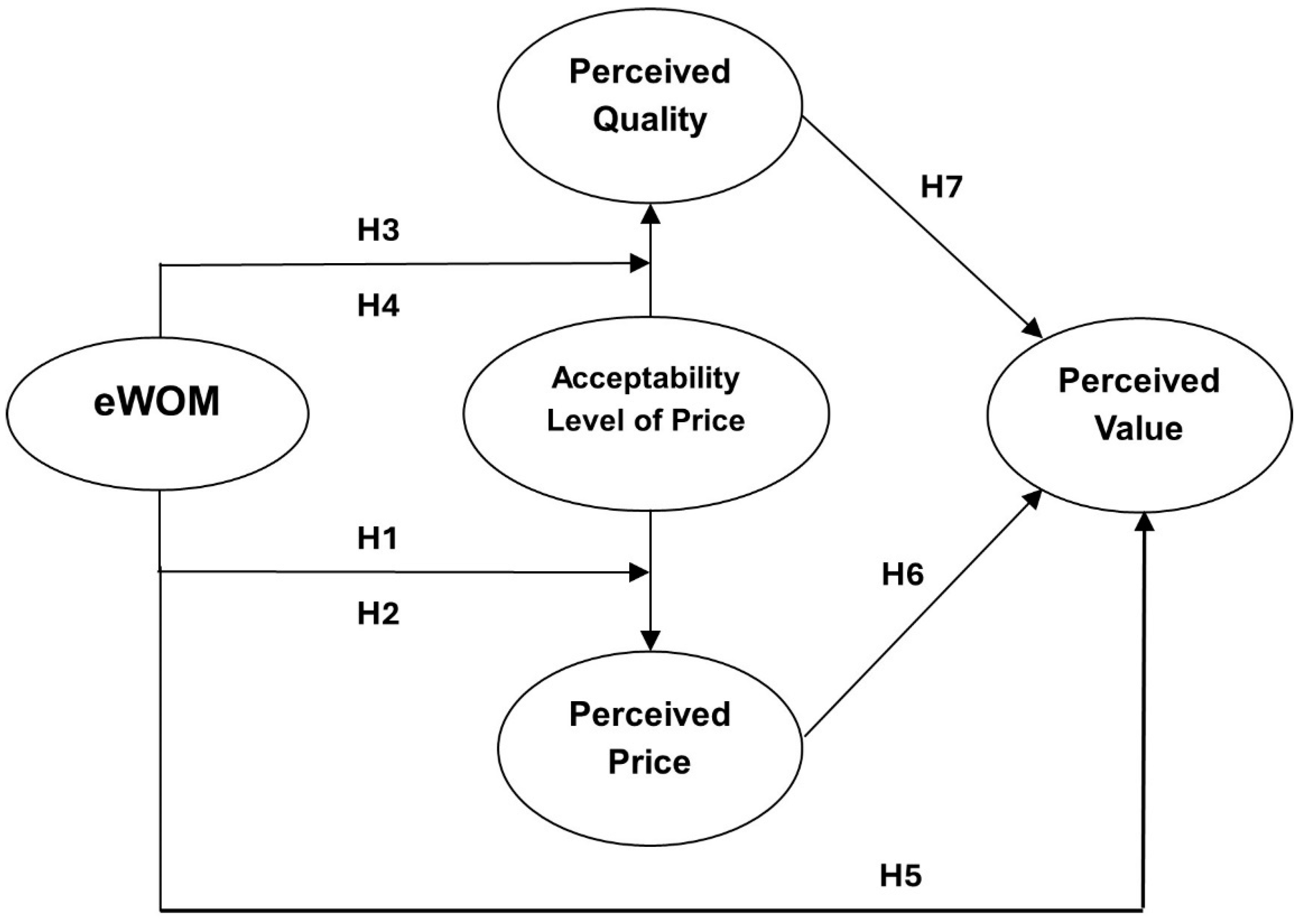

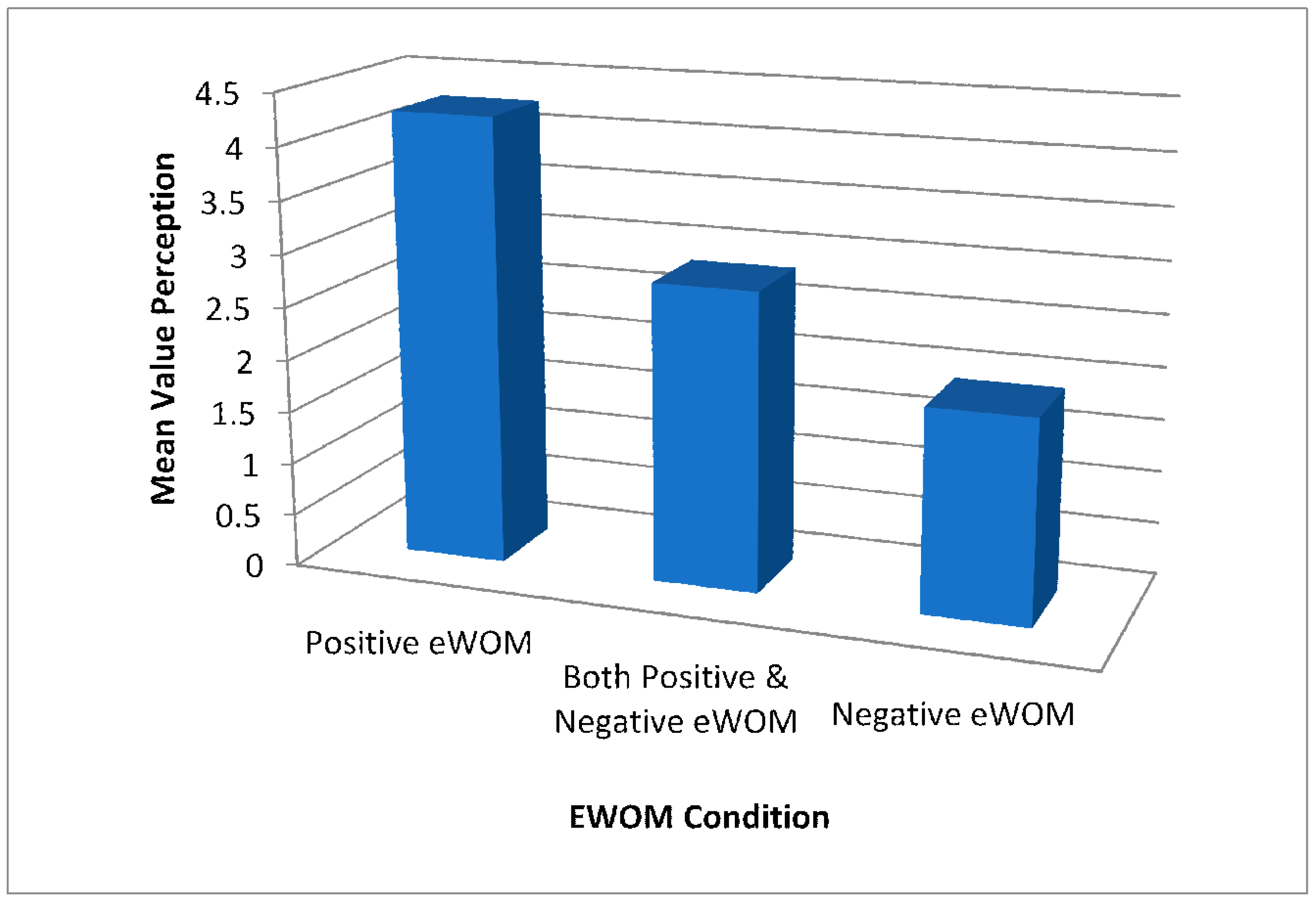
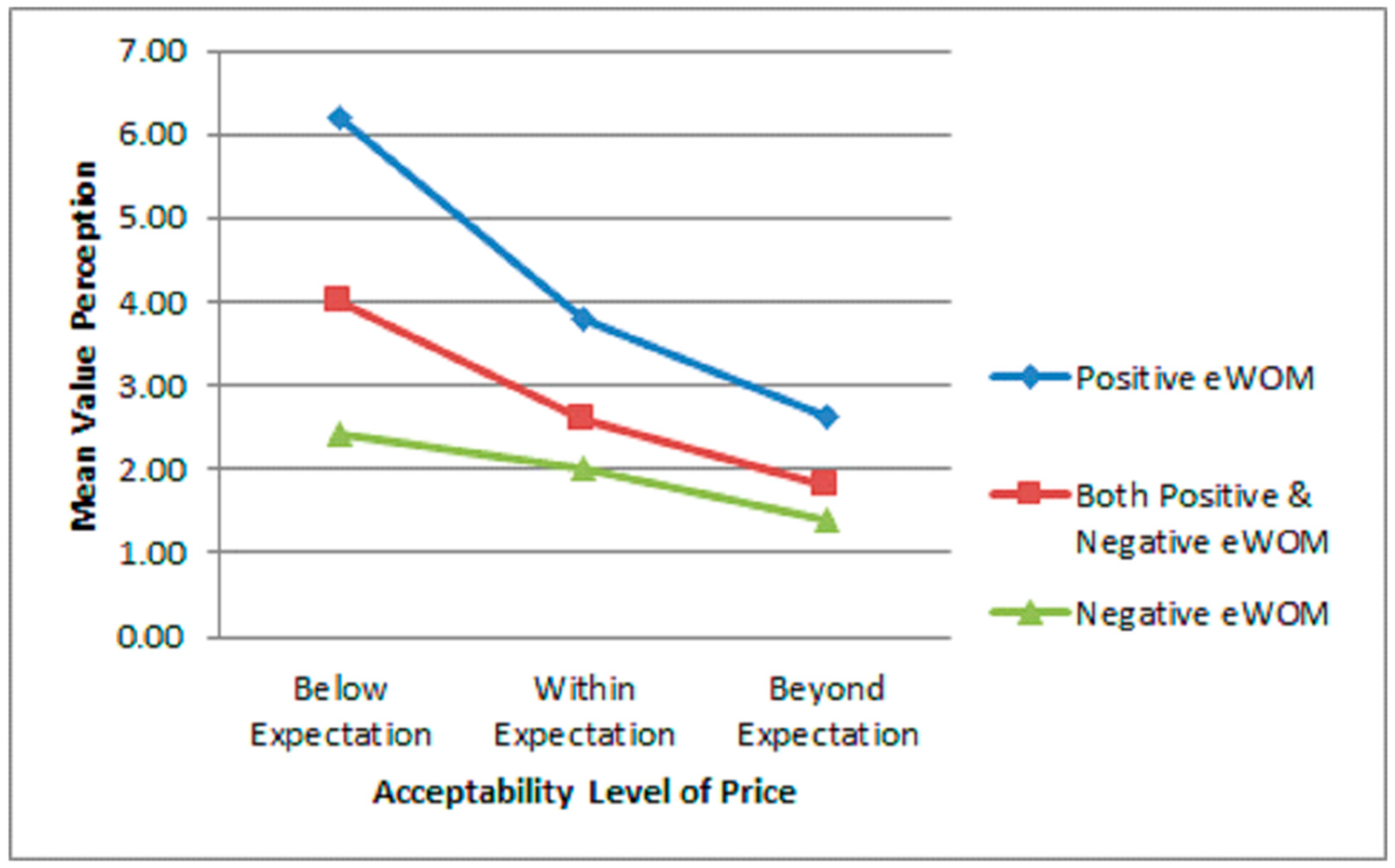
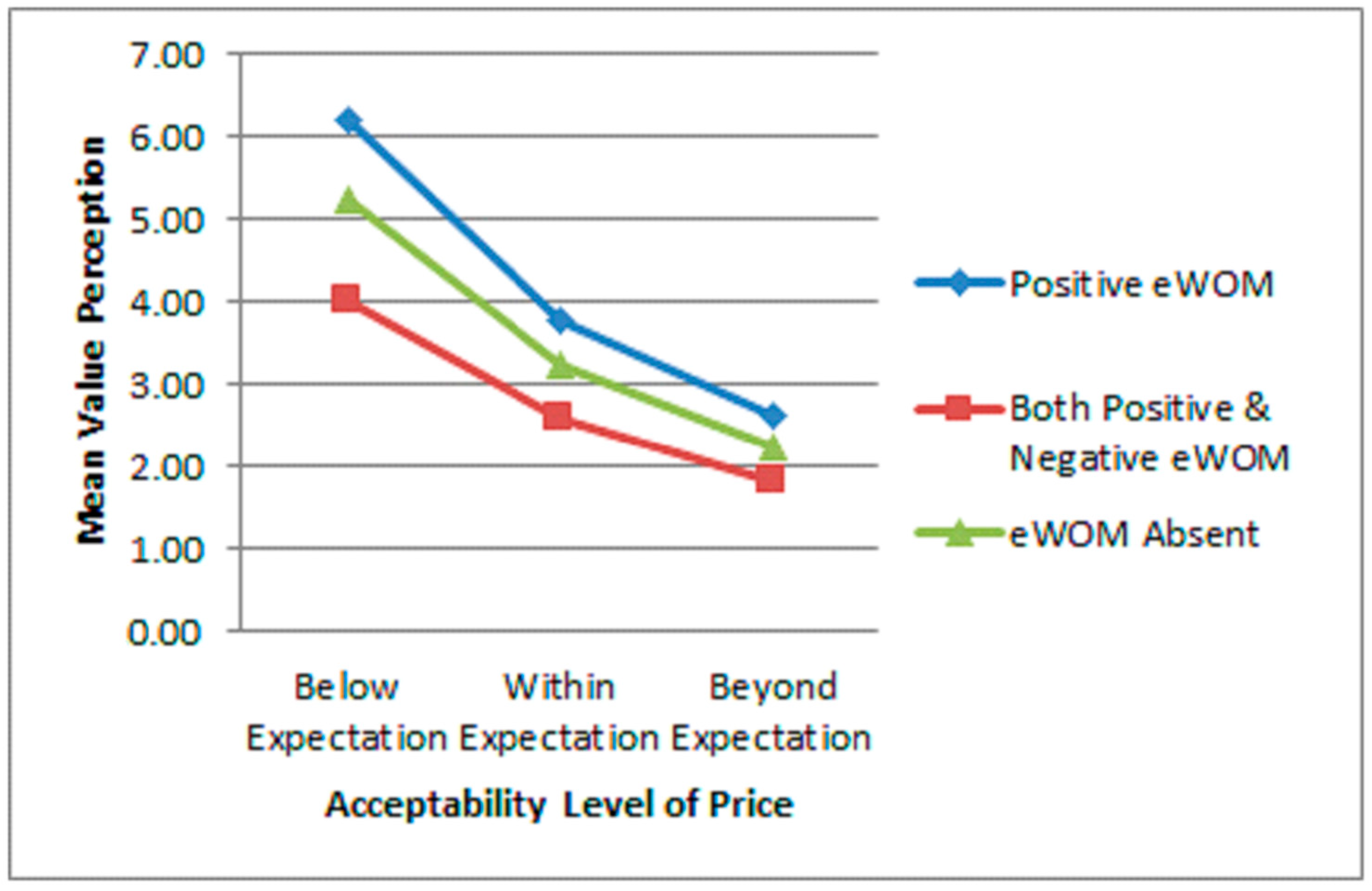
| Group No. | Travel Agent | Conditions | Travel Agent | Conditions |
|---|---|---|---|---|
| 1 | X1 | All positive eWOM, advertised price below respondents’ acceptable range | C1 | eWOM absent, advertised price below respondents’ acceptable range |
| 2 | Y1 | All negative eWOM, advertised price below respondents’ acceptable range | C1 | eWOM absent, advertised price below respondents’ acceptable range |
| 3 | Z1 | Both positive and negative eWOM, advertised price below respondents’ acceptable range | C1 | eWOM absent, advertised price below respondents’ acceptable range |
| 4 | X2 | All positive eWOM, advertised price within respondents’ acceptable range | C2 | eWOM absent, advertised price within respondents’ acceptable range |
| 5 | Y2 | All negative eWOM, advertised price within respondents’ acceptable range | C2 | eWOM absent, advertised price within respondents’ acceptable range |
| 6 | Z2 | Both positive and negative eWOM, advertised price within respondents’ acceptable range | C2 | eWOM absent, advertised price within respondents’ acceptable range |
| 7 | X3 | All positive eWOM, advertised price beyond respondents’ acceptable range | C3 | eWOM absent, advertised price beyond respondents’ acceptable range |
| 8 | Y3 | All negative eWOM, advertised price beyond respondents’ acceptable range | C3 | eWOM absent, advertised price beyond respondents’ acceptable range |
| 9 | Z3 | Both positive and negative eWOM, advertised price beyond respondents’ acceptable range | C3 | eWOM absent, advertised price beyond respondents’ acceptable range |
| Measure | Frequency | Percentage |
|---|---|---|
| Gender | ||
| Male | 95 | 48.0 |
| Female | 101 | 51.0 |
| Others | 2 | 1.0 |
| Education level | ||
| Bachelor’s | 85 | 42.9 |
| Master’s | 69 | 34.8 |
| PhD | 44 | 22.2 |
| Social media usage | ||
| Every day | 161 | 81.3 |
| 4–5 days per week | 18 | 9.1 |
| Once or twice per week | 14 | 7.1 |
| Very rarely | 5 | 2.5 |
| Search for other people’s travel experience or comments | ||
| Very often | 56 | 28.3 |
| Often | 66 | 33.3 |
| Once in a while | 68 | 34.3 |
| Never | 8 | 4.0 |
| Experience of purchasing a group package tour online | ||
| More than once in the past year | 90 | 45.5 |
| Once in the past year | 58 | 29.3 |
| Once in the past two years | 46 | 23.2 |
| Never | 4 | 2.0 |
| Constructs | Number of Items | Mean | Standard Deviation | Cronbach’s Alpha | Composite Reliability | AVE |
|---|---|---|---|---|---|---|
| WOM Perception | 3 | 3.90 | 1.98 | 0.97 | 0.98 | 0.94 |
| Quality Perception | 5 | 3.40 | 1.66 | 0.98 | 0.99 | 0.95 |
| Value Perception | 5 | 2.97 | 1.43 | 0.93 | 0.93 | 0.74 |
| Price Perception | 1 | 3.24 | 1.76 | NA | NA | NA |
| Constructs | WOM Perception | Quality Perception | Value Perception | Price Perception * |
|---|---|---|---|---|
| Perceived WOM | 0.97 | |||
| Perceived Quality | 0.95 | 0.97 | ||
| Perceived Value | 0.66 | 0.58 | 0.86 | |
| Perceived Price * | 0.74 | 0.69 | 0.85 | NA |
| Indicator | Comparison Group | ||
|---|---|---|---|
| 1 (Price Below Acceptable Range and Positive eWOM) | 4 (Price Within Acceptable Range and Positive eWOM) | 7 (Price Beyond Acceptable Range and Positive eWOM) | |
| t-statistic | 0.36 | −0.39 | −0.43 |
| p-value (Significance of difference) | 0.72 * | 0.70 * | 0.67 * |
| d (Difference between each pair of value) | 0.10 | 0.12 | 0.13 |
| Key Indicators | Acceptability Level of Price | ||
|---|---|---|---|
| Below Expectation | Within Expectation | Beyond Expectation | |
| Final Perceived Price and Quality as Predictors: | |||
| R2 | 0.95 | 0.93 | 0.81 |
| Block 1: Final Perceived Price: | |||
| R2 | 0.94 | 0.93 | 0.81 |
| F | 343.20 | 227.37 | 83.81 |
| p | <0.001 | <0.001 | <0.001 |
| Beta | 0.97 | 0.96 | 0.89 |
| t | 18.53 | 15.08 | 9.16 |
| p | <0.001 | <0.001 | <0.001 |
| Block 2: Quality: | |||
| R2 | 0.01 | 0.01 | <0.001 |
| F | 3.40 | 0.99 | 0.002 |
| p | >0.05 | >0.05 | >0.05 |
| Beta′ | 0.16 | −0.12 | 0.01 |
| t | 1.84 | −0.99 | 0.04 |
| p | >0.05 | >0.05 | >0.05 |
Disclaimer/Publisher’s Note: The statements, opinions and data contained in all publications are solely those of the individual author(s) and contributor(s) and not of MDPI and/or the editor(s). MDPI and/or the editor(s) disclaim responsibility for any injury to people or property resulting from any ideas, methods, instructions or products referred to in the content. |
© 2025 by the authors. Licensee MDPI, Basel, Switzerland. This article is an open access article distributed under the terms and conditions of the Creative Commons Attribution (CC BY) license (https://creativecommons.org/licenses/by/4.0/).
Share and Cite
Liang, W.K.; Dahms, S.; Corkindale, D.R.; Liddiatt, J. Reviving from the Pandemic: Harnessing the Power of Social Media Reviews in the Sustainable Tourism Management of Group Package Tours. Tour. Hosp. 2025, 6, 41. https://doi.org/10.3390/tourhosp6010041
Liang WK, Dahms S, Corkindale DR, Liddiatt J. Reviving from the Pandemic: Harnessing the Power of Social Media Reviews in the Sustainable Tourism Management of Group Package Tours. Tourism and Hospitality. 2025; 6(1):41. https://doi.org/10.3390/tourhosp6010041
Chicago/Turabian StyleLiang, Wai Ki, Sven Dahms, David Reay Corkindale, and Joe Liddiatt. 2025. "Reviving from the Pandemic: Harnessing the Power of Social Media Reviews in the Sustainable Tourism Management of Group Package Tours" Tourism and Hospitality 6, no. 1: 41. https://doi.org/10.3390/tourhosp6010041
APA StyleLiang, W. K., Dahms, S., Corkindale, D. R., & Liddiatt, J. (2025). Reviving from the Pandemic: Harnessing the Power of Social Media Reviews in the Sustainable Tourism Management of Group Package Tours. Tourism and Hospitality, 6(1), 41. https://doi.org/10.3390/tourhosp6010041






